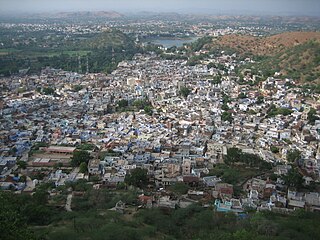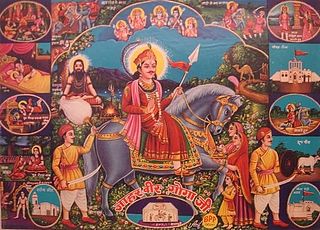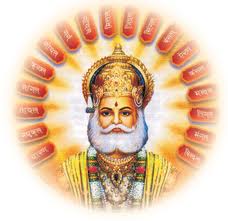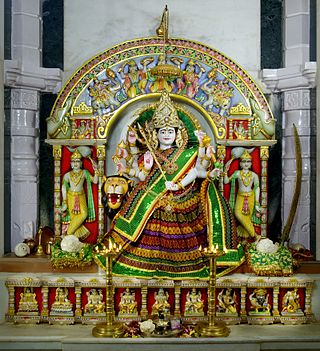
Alwar is a city located in India's National Capital Region (NCR) and the administrative headquarters of Alwar District in the state of Rajasthan. It is located 150 km south of Delhi and 150 km north of Jaipur.

Chauhan, a name derived from the historical Chahamanas, a clan name associated with various ruling Rajput families in the present-day Indian state of Rajasthan from seventh century onwards.

Dungarpur is a city in the southernmost part of Rajasthan, India.

Gogaji, also known as Gogaji Jaharveer Maharaj or Jaharveer Chauhan, is a folk Hindu deity in northern India. He is worshipped in the northern states of India especially in Rajasthan, Himachal Pradesh, Haryana, Uttarakhand, Punjab region, Uttar Pradesh, Jammu and Gujarat. He is a warrior-hero of the region, venerated as a saint and a protector against snake bites. Although there are references to him in the folklore of Rajasthan, little historical knowledge of Gugga exists other than that he ruled the small kingdom of Dadrewa and was a contemporary of Prithviraj Chauhan.

Agrawal is a Bania caste. The Banias of northern India are a cluster of several communities, of which the Agrawal Banias, Maheshwari Banias, Oswal Banias, Khatri Banias and Porwal Banias are a part.
Meo are a Muslim ethnic group originating from the Mewat region of north-western India.

Agrasen, most commonly known as MaharajaAgrasen, was a legendary Indian king of Agroha, a city of traders in the district of Hisar, Haryana. He is a descendant of the Hindu deity, Shri Ramchandra's elder son, Kush. He is credited with the establishment of a kingdom of traders in Northern India named Agroha, and is known for his compassion in refusing sacrificial slaughter of animals in yajnas. Goddess Mahalakshmi bestowed prosperity for him and his descendants.
The Dugar is a gotra belonging to the Jain Oswal community of Rajasthan.

Dhani or Thok is a type of hamlet, the smallest conglomeration of houses, in the sandy Bagar region of the northwestern states of Rajasthan, Haryana and Punjab in India. Per the Census of India, 70% of Indians live in villages. 80% of the villages have a population of less than 1000 people and each consists of a cluster of hamlets. Most dhanis are nucleated settlements, while others are more dispersed. A dhani could be as small as one isolated house for a single family or a small cluster of several houses which could grow in number with successive generations, and even become a village by itself. All families living in a dhani are relatives or at least are of the same caste. An isolated collection of several dhanis, which could be few hundred meters apart, constitutes a gram panchayat village community. A typical dhani in the arid zone of Rajasthan is a cluster of huts with a boundary made of dried shrubs around it and with owners' livestock such as goats, sheep and camels inside the bara. Dhani are atypically mud huts in Rajasthan. Houses in dani nowadays are made of modern brick and mortar, specially in affluent higher-per-capita-income states of Haryana and Punjab, and some richer families of Rajasthan.
Vijayvargiya is a merchant or (Vaishya-Baniya) community mainly from Rajasthan and Madhya Pradesh.
The Natrayat Rajputs are Hindu caste found in the state of Rajasthan in India.

Chhipi is a caste of people with ancestral roots tracing back to India. These people are basically Rajputs and used to wear Kshatriya attire. These people were skilled in the art of war, Later people of this caste started doing printing work. They are found in the states of Gujarat, Rajasthan, Madhya Pradesh, Haryana, Delhi, Uttar Pradesh of India.
Kuteena is a village in the Neemrana subdistrict of the Alwar District in the state of Rajasthan in India. It is located in the foothills of Aravali.
The Sikligar is a community found in the Indian states of Gujarat, Haryana, Rajasthan, and Punjab. By tradition, the Sikligar people specialized in the craft of making and polishing weapons. They are typically Hindu in Gujarat, Telangana, and Andhra Pradesh; Sikh in Punjab; and either Hindu and Sikh in Haryana.

Dungarpur State was a princely state during the British Raj. Its capital was the city of Dungarpur in the southernmost area of present-day Rajasthan State in India. In 1901 the total population of Dungarpur State was 100,103, while that of the town was 6,094.

Ashapura Mata is an aspect of Devi, a Hindu goddess. She is one of the kuldevis of Kutch and Rajasthan, and the Jadeja clan of Gujarat, Chauhans and Patiyats inhabiting the western Indian provinces. She is a goddess regarded to fulfill the wishes of her adherents.
Balonda is a village in the Indian state of Rajasthan. Its mandal is Surajgarh and district is Jhunjhunu. It is located 17.7 kilometres (11.0 mi) from Surajgarh, 54.2 kilometres (33.7 mi) from Jhunjhunu, and 157 kilometres (98 mi) from Jaipur.
The Orh is a drifting tribe of labourers in Sindh, Gujarat, Kathiawar, and some parts of Rajasthan. They drift and shift lock, stock, and barrel with their families wherever work is to be done. They are said to hold a variety of occupations. As artisans, they are carpenters, masons and stoneworkers and were considered to be Dalits. As traders, they deal in grain, spices, perfumes, and cloth. They are spread across 40 villages in Uttarakhand and Uttar Pradesh. In reality, Odh is a word for people who built mud huts rather than a caste; yet, but it is used as a caste in Pakistan. They claim their original name was Sagarbansi or Sagarvanshi they bear surnames like Gadahi, Bhagat, Galgat, Kharwar, Kahlia, Kudavali, Maangal, Majoka, Mundai, Sarvana, and Virpali.

The Chahamanas of Shakambhari, colloquially known as the Chauhans of Sambhar or Chauhans of Ajmer, were an Indian dynasty that ruled parts of present-day Rajasthan and neighbouring areas between the sixth and twelfth centuries in the Indian subcontinent. The territory ruled by them was known as Sapadalaksha. They were the most prominent ruling family of the Chauhan Rajput clan.
Delwara, nestled in the Aravalli Range hills, is a small town about 28 km away from Udaipur, Mewar, and close to Eklingji Temple, on the way to the temple town of Nathdwara, in the state of Rajasthan, India. Delwara was originally known as ‘Devkul Patan Nagri’, which means the town of god. It boasted over 1500 temples at one time, out of which there were over 400 Jain temples. Delwara was the center of learning and culture before the 15th century AD. Around the middle of the 13th century, Raja Sagar, a Deora Chauhan and a descendant of Rao Kirtipal of Jalore, was a very brave king of Delwara (Mewar). Descendants of Raja Sagar sacrificed their lives while fighting alongside Ranas of Mewar against Muslim invaders. Raja Sagar was the progenitor of Bachhawat and Bothra clans of Oswals. Sagar's son, Kunwar Bohitya was immensely influenced and inspired by Jain philosophy. Samdhar, a grandson of Bohitya and a Deora Chauhan, was the first man in his genealogy to convert to Jainism.








